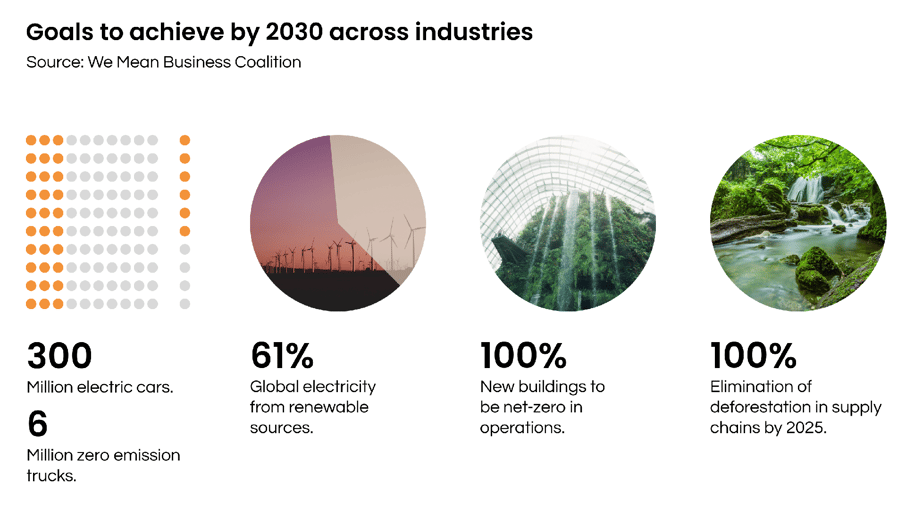What We've Learnt From The Climate Summit COP27

With more than 45.000 participants from all over the world, the 27th edition of the Conference of the Parties (COP27) just wrapped up in Sharm el Sheikh, Egypt.
After two intense weeks, it’s time to look back on the outcomes of the climate summit.
Therefore, this article will cover the main takeaways of the event as well as the key implications for the private sector.
COP27: What happened?
Key topics and ambitions
As we’re rapidly running out of time to tackle the climate crisis, COP27 aimed to move from negotiations to implementation. Hence, the goal of the summit consisted of translating previous agreements and commitments into concrete projects and climate action.
The climate change conference focused on 4 key themes:
-png-1.png?width=906&height=528&name=Figure%201%20(1)-png-1.png)
1. Mitigation
Re-confirming the ambition set in the Paris Agreement, it’s imperative to stick to the 1.5°C pathway. In fact, climate science predicts that under a 2°C scenario:
- 37% of the global population could regularly be exposed to extreme heat waves, compared to 14% under the 1.5°C;
- Dangerous tipping points would be surpassed accelerating even more global temperature increase and climate change effects.
Additionally, COP27 highlighted the importance of cutting methane emissions to achieve climate targets. In fact, at least 25% of global warming is caused by methane emissions (Environmental Defense Fund (EDF).
According to the Global Methane Pledge, we need to cut methane emissions by at least 30% by 2030 to keep the 1.5°C scenario within reach.
Finally, countries need to check and adjust their Nationally Determined Contributions (NDCs) as well as move forward with decarbonisation solutions.
2. Adaptation
Significant attention is directed to increasing climate resilience. Particularly towards the most vulnerable countries, which also happen to be the least contributors to climate change.
According to a Global Carbon Atlas study (2019), Least Developed Countries accounted for just 1.1% of global CO2 emissions from industrial processes and burning fossil fuels.
Additionally, objective of the discussion is the 2009 $100 billion per year pledge. The former was submitted by wealthier countries to support mitigation and adaptation in developing nations. However, according to OECD, signatory countries are still $17 billion behind their promise.
3. Finance
As mentioned above, attention still needs to be put on climate finance. Existing commitments and pledges need to be followed up on.
4. Collaboration
Countries, governments, the private sector, and civil society need to join efforts to facilitate a ‘just transition’. Some of the key initiatives aimed to enhance the creation of partnerships are:
- UN Global Compact
- The First Movers Coalition
- The Mission Possible Partnership
- The We Mean Business Coalition
Draft Decision Document
COP27 official text was finalised last Sunday. On one hand, progress was made through the Loss and Damage Fund. On the other hand, the decision document lacks commitments to limiting global warming to 1.5°C and the phase-out of fossil fuels.
The Loss and Damage Fund for vulnerable countries is surely a big milestone of COP27. However, adaptation costs are estimated to range from $160 to $340 billion annually and still no decision has been made concerning who is going to pay.
For now, the COP27 text defines:
- Who oversees the fund;
- How the money will be spent;
- Who would benefit from the funding.
For the above, COP27 nominated a transitional committee responsible for operationalising the funding.
The front of emission reduction and fossil fuel phase-out has been instead highly criticised.
Despite the need for countries to strengthen their National Climate Targets before the Egypt Summit, only a few of the 200 Parties did so.
Additionally, COP27 deal pulls back on the previous Glasgow commitment to yearly check and revamp national climate goals. Indeed, the new agreement brings back the longer 5-year review period.
Another central topic of discussion was climate finance. In the final agreement, the Parties state that to reach net-zero emissions by 2050 it’s pivotal to:
- Invest between $4 to $6 trillion a year in renewable energy until 2030;
- Invest in technology and infrastructure.
Key implications for businesses
The private sector plays a crucial role in decarbonising our economies.
According to the We Mean Business Coalition, by 2030 industries should join efforts to achieve:
- At least 300 million electric cars and 6 million zero-emission trucks on the road;
- At least 61% of global electricity produced from renewable sources;
- 100% of new building projects to be net-zero carbon in operations;
- Deforestation eliminated from supply chains by 2025;
- Comparable and complete corporate climate-related financial disclosure.
 Based on the discussions that took place at the COP27 Business Pavilion, the private sector should focus on the following key areas.
Based on the discussions that took place at the COP27 Business Pavilion, the private sector should focus on the following key areas.
Shifting towards a net-zero energy system
Businesses can accelerate the shift towards a net-zero energy system by:
- Increasing demand for renewable electricity;
- Using low-carbon technology and fuels.
Interesting initiatives to look out for are:
- RE100: a global corporate renewable energy initiative that gathers more than 380 large businesses committed to 100% renewable electricity;
- Clean Energy Investment Accelerator: the initiative has directed over $50 million to finance clean energy projects in emerging markets.
Building a zero-carbon transport system
The private sector can push the adoption of electric vehicles by upgrading their fleet and transport choices. Relevant initiatives one could join are:
- EV100: is a Climate Group initiative that aims to accelerate electric transport, making it the new normal by 2030.
- Sustainable Freight Buyers Alliance (SFBA): organisations joining this initiative will contribute to the decarbonisation of freight transport by:
-
- Enhancing collaboration between suppliers and buyers;
- Optimising sustainable procurement solutions and decarbonisation projects;
- Monitoring and reporting progress.
Increasing supply and demand for low-carbon and circular materials
Organisations can decarbonise their supply chain by purchasing less impactful materials. Additionally, they are encouraged to find ways to increase circularity within their operations.
- Mission Possible Partnership: the initiative gathers climate leaders wanting to decarbonise the highest emitting industries – aluminium, aviation, chemicals, steel - by 2030.
Financing the low-carbon transition
Financial markets need clear and high-quality information concerning climate-related risks and opportunities for businesses. Hence, transparent climate disclosure is key to allowing informed decision-making and tracking where financial resources are directed.
Conclusion
COP27 was put forth as the Climate Summit for implementing solutions, rather than discussing plans. Hence, organisations have a central role to play. They can take bold and prompt action to accelerate the fight against climate change and show policymakers their willingness to contribute.
Moreover, public-private initiatives and intersectoral collaborations are on the rise. Hence, businesses are seen as the main leaders in implementing change.
In practical terms, organisations must:
- Assess climate risks and impacts to understand where the biggest opportunities lie.
- Integrate net-zero ambition in the corporate climate strategy.
- Collaborate with suppliers and the surrounding community to enhance resilience.
- Support adaptation efforts.
- Increase efficiency and invest in climate change mitigation.
- Embed sustainability in products, services and business models.
- Communicate through transparent climate disclosure.